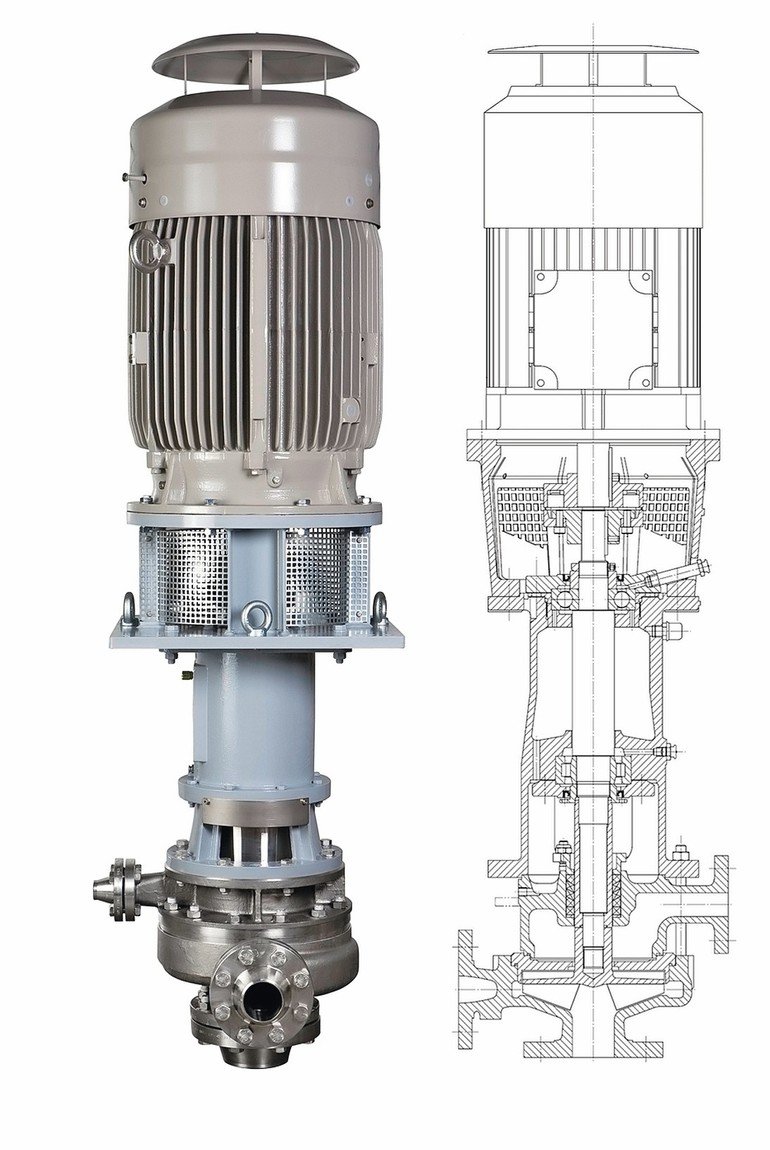Sealing systems are supposed to seal off the rotating shaft against the surrounding environment. When selecting a suitable seal for pump shafts between the atmosphere and the working fluids, it is important to consider the hazard potential. TA Luft (German clean air regulations), the maximum workplace concentration or Atex guidelines, for instance, describe the requirements for shaft seals and specify their technical data. Sealing systems for innocuous media represent the biggest group. A stuffing box (possibly in combination with a hydrodynamic seal), magnetic coupling, canned motor or mechanical seal may be used for this purpose. Labyrinth seals which are open to the outside environment with pumping and locking devices, stuffing box packings made from different materials and lubricated with water, grease or graphite and shaft seal rings are three popular choices. Three approved systems remain for fluids with medium to high hazard potential, namely double mechanical seals, magnetic couplings and canned motors. Double mechanical seals are generally liquid-lubricated. Their disadvantage is that they require a sealing system. This is a complex task and the maintenance costs are high. Magnetically coupled pumps can often be a good alternative.
Magnetically coupled pumps
If centrifugal pumps are used with a magnetic coupling, the motor shaft is fitted with an external magnetic rotor in so-called block design. This rotor transfers the magnetic forces through a containment can to the internal magnetic rotor. The pumped medium flows around the containment can and the slide bearings. Conventional magnetically coupled and canned motor pumps do not work independently of the pumping medium, which must be able to flow around the containment can and the slide bearings (which in turn must not be allowed to run dry). Solids, gas-laden and magnetisable media can only be pumped in this way if additional measures such as external flushing are provided. The fluid is hermetically shielded from the surrounding environment by the containment can. However, the risk of fracture is a problem which is rightly feared! In this case, the liquid under pumping pressure escapes into the atmosphere in an uncontrolled manner. Furthermore, solids in the medium may block the cooling channels to the containment can or destroy the bearing. The wear on the containment is consequently higher. If the medium contains gases, boiling or outgassing substances or low-viscosity liquids, the lubrication of the slide bearing tends to be interrupted, leading to stalling and process downtime. Heating of the partial flow (due to the induced eddy currents in the coupling’s containment can) can additionally result in undesirable or even dangerous heating of the medium. Dry-running safety can only be achieved with complex and cost-intensive supplementary measures.
Intelligent sealing technology
Permanently dry-running, magnetically coupled pumps have proved effective for pumping hazardous liquids as well as solids and gas-laden media. These horizontal pumps are hermetically sealed. Their (Atex-compliant) ceramic containment can runs without any product contact, ensuring eddy current and heat-free magnetic field transmission. With grease and lifelong-lubricated roller bearings, the MPCH DryRun manages with virtually no maintenance. It has an intrinsically safe design with a dry-running and depressurised magnetic coupling: dry-running lip seals protect the system with a triple-seal arrangement. This completely non-wearing sealing and bearing technology operates independently of the pumped medium. The inlet pressure of the medium is only applied to the labyrinth seal, which operates without friction. The sealing gas atmosphere contains no oxygen, moisture or solids. The system survives several hours of dry running or even operating errors unscathed. Difficult pumping tasks are handled very efficiently by the vertical pumps in the V-AN range. Their advantages – self-regulation, dry running and dependability – are further underlined by the seal. The V-AN range of pumps have proven successful all over the world in systems containing gas-laden mixtures or media at boiling point. Their possible applications extend from toxic waste water through hazardous or outgassing liquids to solids-laden, sludgy, crystallising or corrosive media.
Turbulences within the tank
As in many industrial sectors, condensate in this application is pumped from a water-steam circuit. The boiling hot medium causes high turbulences within the tank. Following transfer to a flash tank and appropriate cooling, the process continues by pumping the medium into a neutralisation tank. Conventional pumps require an additional condensate collecting tank to store the almost steamless condensate. Level control is likewise necessary to make sure that the level is higher than the pump’s NPSH value (NPSHA NPSHR +0.5 m). A pit is often the only way to conform to the stipulated overall height of this installation. “The self-regulating VKS-AN pump is provided with pressure compensation. Its NPSHR value is thus almost zero and it can pump directly from the tank. Gas or steam is discharged via a compensation line. Even entrained gas or steam bubbles do not cause stalling”, explains Frank Bungartz, General Manager of the pump manufacturer of the same name (Achema: Hall 8, Booth C1). High volumes of solids and gases are permitted. The special sealing lips in this pump type are installed in front of the first bearing unit, to protect it from product vapours. The required gas barrier volume flow and pressure are within the normal range. If the sealing gas supply fails, the sealing lips are closed because the gas no longer flows between them and the shaft sleeve. Dry running for several hours – an aspect which can be a direct cause of damage with gas-barrier mechanical seals – does not represent a problem for lip seals. They are moreover safe to use, economical and low on maintenance. The gas-barrier seal has undergone helium leak testing at the German Technical Inspection Agency (TÜV) and is approved under the provisions of TA Luft.
Online search: cpp0118bungartz








